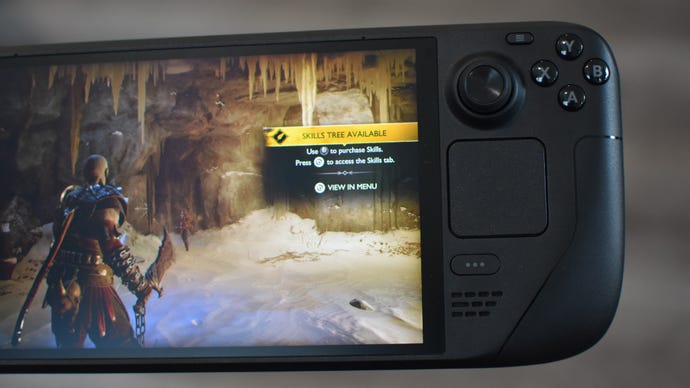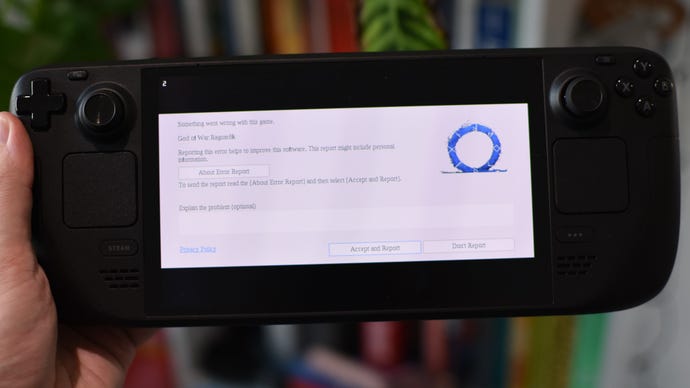Products You May Like
God of War Ragnarök initially looks like it has little trouble with squeezing itself into a Steam Deck. Yet like a flask of mead laced with Odin’s raven piss, the seemingly crisp treat of Ragnarök’s handheld performance masks a nasty blend of technical troubles and what is, essentially, an always-online requirement by stealth.
Let’s start with the positives. Ragnarök breaks the recent streak of big-money, big-spectacle games being too much for the dinky Deck; it actually runs quite smoothly, and not solely by PS5 port standards. Full settings guide gubbins below but in short, you can get a very comfortable 40-50fps on a mix of Medium and Low settings, and while that’s helped in part by FSR 3.1 upscaling, you can keep this on Quality mode so it barely looks any different to native 800p.
In a way, then, this is the Steam Deck at its pluckiest, pulling out a surprising capable showing for a game that could feasibly have ran at the frames-per-second of an Argos catalogue. It controls well, too, and never presents any issues with the quick suspend/resume feature. And, just as Valve intended, full Steam Cloud support also ensures your save files will carry over between a Deck and a desktop PC, should you switch between them.
Half an hour or so in, it really was looking like one of the better examples of the portable AAA form, even with some potential minor blemishes. For one, it’s a heavy drinker, running my Steam Deck OLED dry in 2h 08m – the joint-shortest of anything I’ve tested, along with Like a Dragon: Infinite Wealth. Second, it simply won’t fit on the smaller Steam Deck SSDs, thanks to a colossal installation size of 176GB. That does include the Valhalla roguelike mode DLC, but still.
Sadly, these are petty complaints compared to what else can go wrong with Ragnarök on a Steam Deck. Bugs can both annoy and, potentially, halt the game entirely: I got so much sustained audio crackling on my OLED that I ended up switching to an older LCD Deck, as much to escape it as to test out a different model. And on both machines, the controls became unresponsive upon being served a particular pop-up tutorial tooltip; this also forcibly pauses the game, making it impossible to progress unless a solution can be bodged.

In my case, I ended up having to plug in a docking station, connect my PS5 gamepad, and press the offending button on that to make the tooltip sod off. A Razer-made Xbox controller I had to hand also didn’t work, and while in hindsight I wonder if the touchscreen or onscreen keyboard might have helped, I really shouldn’t have to workshop solutions to a game-blocking bug like this in the first place.
Yet at least a workaround exists there. The same can’t be said for Sony’s utterly unnecessary PSN login requirement, which has been foisted upon Ragnarök just as it was Ghost of Tsushima. The consequences aren’t as ruinous here as they were in Ghost, as God of War has no online multiplayer modes to block off, but the need to check in with PSN at every boot does cause extra trouble for handhelds like the Steam Deck: if you try launching in SteamOS’ offline mod, as you likely would when you’ve taken the portable PC anywhere outside your house, then Sony’s service gets so confusedly irate that it crashes the game. Every time, without fail.

I don’t think I need to spell out why this a profoundly daft bit of login creep. But what amounts to an inconvenience on a home desktop can, evidently, undermine a portable PC’s entire reason for being, so it’s important that we vocally reject at every halfway-decent opportunity.
Those technical snags also undermine the game itself, which like I say, is a very respectable performer considering it rolled out of Sony’s famously monied first-party factory. The Low preset on native 800p makes for a playable 30fps, but by swapping for FSR 3.1 on Quality mode – which really doesn’t look that much worse – you can afford to crank up some of the individual settings to Medium while also enjoying a slicker 40-50fps range. Here’s what I settled on, when I wasn’t frozen in time with tutorial magicks:
- Scaling method: AMD FSR 3.1
- Scaling quality: Quality
- Textures: Medium
- Models: Medium
- Anisotropic filter: Medium
- Lighting: Medium
- Shadows: Low
- Reflections: Low
- Atmospherics: Medium
- Ambient occlusion: Medium
- Tessellation: Low
- Motion blur: 0
FSR 3.1 frame generation is also up for grabs, though it usually only adds 4-5fps to what you’d get with the core settings above. To my eyes, that just isn’t worth the input lag and occasionally blurred motion that it adds.
